Welcome to How to Resist, a blueprint for resistance based on nonviolence, mutual aid, and community building for ordinary people who want to save democracy.
(Listen to the author’s letter by pressing the play button above.)*
Dear Resisters,
At the end of May, the Trump administration announced a new quota of 3,000 immigration arrests a day, a figure that is triple what it was earlier this year. As a result, this week, across the country, we saw a sharp escalation in immigration enforcement tactics: militarized raids, surprise detentions during routine check-ins, and the targeting of Hispanic communities and places of work.
But what stood out to me the most this week wasn’t the cruelty of these tactics; it was the courage of the response.
In Chicago’s Little Village, neighbors spotted unmarked vans and mobilized within minutes, forcing ICE to retreat. In Massachusetts, students and teachers walked out of school to demand the release of a classmate. In Los Angeles, protesters surrounded federal agents while under fire from rubber bullets and flash bang grenades. In courtrooms from California to D.C., judges are pushing back, insisting that due process matters.
These moments remind us that resistance is about showing up for each other. What we are witnessing is an unjust, state-sanctioned campaign of terror. And in this moment we need to decide where we stand; in some cases, quite literally. Rapid response networks are leaping into action in communities across the country, and individuals are using their very bodies to disrupt ICE by blocking entrances to detention centers, forming human chains, and placing themselves between armed masked agents and people under threat.
As I always say, I’m a librarian. My job here is not to tell you what to do but to give you the information you need to make informed decisions about how you participate in the resistance.
So this week, let these stories guide you. There’s no sugarcoating what we’re up against. But there’s also no denying the strength of what we’re building together. Every protest, every blocked entrance, every lawsuit, every act of defiance is a reminder that we are not powerless and the America we believe in still exists.
M-.
Support How to Resist
As a librarian writing in the service of democracy, I’m determined to keep How to Resist free to read and publicly available for everyone.
Each post takes bout 12-15 hours to research, write, and record, and with fewer than 1% of readers supporting How to Resist with a paid subscription, we are still a long way from being fully funded.
If this work matters to you and you’re able to support it, please consider a paid subscription and help keep How to Resist going for as long as it’s needed.
Prefer a one-time contribution? You can donate at ko-fi.com/howtoresist
A Thousand Fires Everywhere
Santa Cruz Protesters Form “Resist!” Banner Against Trump Policies
Nearly 1,000 people gathered at Santa Cruz Main Beach to form a massive human banner reading “Resist!” in protest of the Trump administration’s actions. Organized by Indivisible Santa Cruz County and local activist Becca Moeller, the demonstration also celebrated the 50th anniversary of Santa Cruz Pride, showing solidarity with the LGBTQ+ community.
The 220-foot-long banner, with letters 70 feet tall, included the message “No Going Back,” echoing the Pride event’s theme and reinforcing the community’s commitment to resisting regressive policies targeting LGBTQ+ communities and trans folks.1
8 Arrested During Capitol Protest Against GOP Budget Cuts
Rev. William Barber and seven others were arrested during a prayerful protest in the Capitol Rotunda, again, while opposing a Republican budget bill that would cut healthcare and social services for millions. The action was part of the Moral Monday movement, which is mobilizing faith leaders and low-income Americans to resist policies that deepen inequality.
Barber emphasized that this is not just about one administration, but about a broader political agenda that harms the poor. With poor and low-wage people making up a growing share of the electorate, the movement is focused on long-term change, not just stopping one bill, but building power for the long run.2 3

Tesla Takedown Grows Even After Musk Departure
What began as a small protest outside a Tesla showroom in Boston has grown into a global movement. The Tesla Takedown campaign, sparked by concerns over Elon Musk’s political influence and the lasting damage caused by DOGE, has expanded to over 50 locations worldwide. Organizers are now planning broader actions, including pressuring governments to divest from Tesla and Musk’s other ventures.
Despite Musk’s departure from the White House, participants say the protests will continue. They see the campaign not just as a response to one figure, but as part of a larger resistance to authoritarianism and corporate overreach. With Tesla’s sales and stock price down, organizers believe their efforts are having an impact, and they’re determined to see their mission through.4


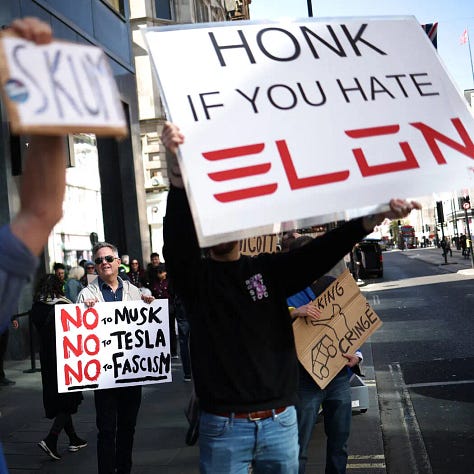
California Pushes Back Against Trump Threats Over Transgender Athletes
The California Department of Education is urging school districts to stand firm in support of transgender students, despite threats from the Trump administration to penalize schools that allow trans athletes to compete. The state reaffirmed its commitment to laws that protect students’ rights to participate in sports consistent with their gender identity, rejecting federal demands.
The controversy follows a high-profile track meet where a transgender athlete, AB Hernandez, won three medals. While the federal government claims such participation violates civil rights protections for girls, California officials and advocates are defending the student and the state’s inclusive policies. With this resistance to federal pressure, organizers and educators are signaling they won’t back down.5
“Let’s be clear: sending a letter does not change the law. The DOJ’s letter to school districts does not announce any new federal law, and state law on this issue has remained unchanged since 2013. California state law protects all students’ access to participate in athletics in a manner that is consistent with their gender identity. We will continue to follow the law and ensure the safety of all our athletes.” — Tony Thurmond, State Superintendent of Public Instruction
Scientists Hold a 100-Hour Livestream to Protest Trump’s Climate Cuts
In response to sweeping federal cuts to climate and weather research under the Trump administration, over 200 U.S.-based scientists held a 100-hour livestream to raise public awareness and defend critical scientific infrastructure. The event, timed to coincide with the start of hurricane season, featured continuous presentations from meteorologists and climate researchers highlighting the risks posed by funding cuts, staff layoffs, and office closures at agencies like NOAA and NASA.
Organizers stress that these cuts threaten public safety by undermining weather forecasting and climate preparedness. Former National Weather Service leaders and recently dismissed NOAA staff have joined the effort, warning of real-time impacts and long-term dangers. With over 100,000 views, the livestream has become a rallying point for public engagement, urging viewers to contact lawmakers and demand restored funding for science that protects lives and communities.6
California Educators Push Back Against Trump’s Cuts to English Learner Programs
California educators and advocates are speaking out against the Trump administration’s proposed elimination of federal funding for English learners and immigrant students. The cuts would dismantle Title III programs that support language instruction, tutoring, and family outreach— services that schools are legally required to provide. Educators warn that the move violates civil rights protections and would force districts to divert resources from other students.
Despite the threat, leaders across California are refusing to back down. They’re defending bilingual education as evidence-based and essential, and they’re calling on lawmakers, including those in conservative states with strong bilingual traditions, to reject the cuts.7
‘Dump Trump’: Labor and Community Protest Trump’s Attacks on Workers and Public Services
In southern Illinois, union members and community activists are holding weekly “Dump Trump” protests to push back against the administration’s attacks on labor rights and public services. Despite pouring rain, demonstrators gathered outside the St. Clair County Courthouse to defend pensions, Medicare, and the rights of federal workers. Organized by local labor councils and Democratic groups, the protests are open to all who oppose what they describe as the erosion of constitutional protections.
In Edwardsville, a separate weekly protest has grown from a single participant to hundreds. Protesters say they’re standing up for workers, retirees, and vulnerable communities affected by mass layoffs and program cuts.8
“It’s easy to break something. It’s harder to put it back together.” —Dennis Barker, Steelworkers Organization of Active Retirees (SOAR)
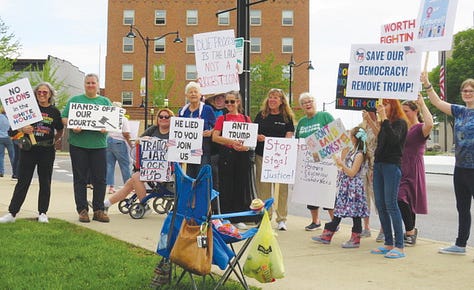

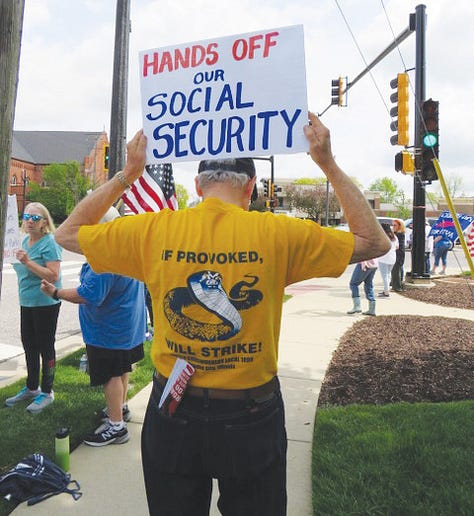
Trump Critic, ‘Anonymous,’ Challenges Trump’s Retaliatory Investigation in Legal Complaint
Miles Taylor, the former Homeland Security official who anonymously criticized Donald Trump in a 2018 op-ed, has filed a formal complaint with federal Inspectors General, accusing the Trump administration of abusing executive power to retaliate against dissent. Taylor is challenging a presidential memo that ordered an investigation into him and another former official, calling it unconstitutional and politically motivated.9
Seniors Rally Against Trump’s “Big Beautiful Bill” and Its Cuts to Safety Nets
In Leimert Park, a historic center of Black civic life in Los Angeles, seniors and community leaders gathered to protest the Trump administration’s “Big Beautiful Bill,” which proposes deep cuts to Medicaid, Medicare, and SNAP. Faith leaders, labor organizers, and residents condemned the bill as an attack on the most vulnerable, especially the elderly, low-income families, and people with disabilities.10
“To my seniors… you’ve worked hard, you sacrificed, you paid into a system with every paycheck. Not as an act of charity, but an act of contract. A promise that when your time came, this country would honor its words. That’s what Social Security, Medicaid, and Medicare represent.” —Yvonne Wheeler, Los Angeles County Federation of Labor

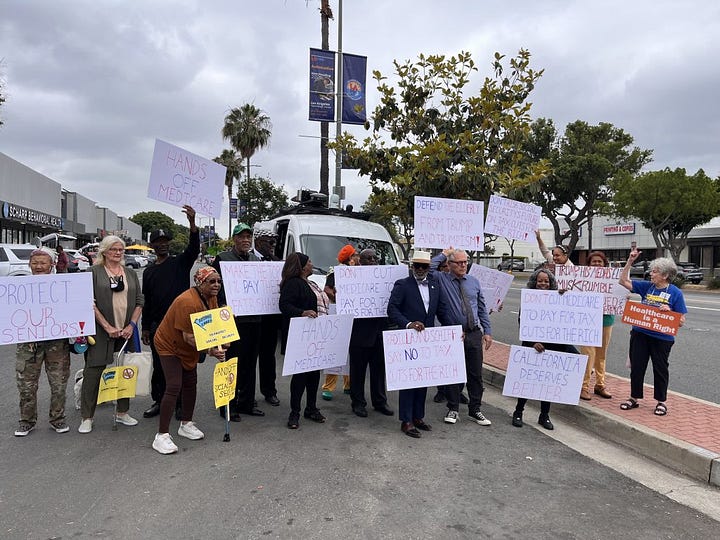
Charlottesville Clergy Protest Cuts to Social Programs
In Charlottesville, Virginia, the Clergy Collective gathered in front of the Free Speech Wall to protest Trump administration policies, especially the “Big Beautiful Bill,” which proposes deep cuts to Medicaid and SNAP. Framing their action as both protest and spiritual nourishment, faith leaders emphasized the need to sustain resistance through community and shared values. The group plans to hold monthly demonstrations in solidarity with Rev. William Barber’s Moral Mondays.11
“From the poor, immigrants, trans folks, our black, brown, Indigenous neighbors, all of our neighbors who are part of vulnerable populations are being attacked by this administration. And as leaders of faith and people of moral conscience, we can’t allow that to stand without speaking out against it.” —Reverend Karen Mann, Sojourners United Church of Christ
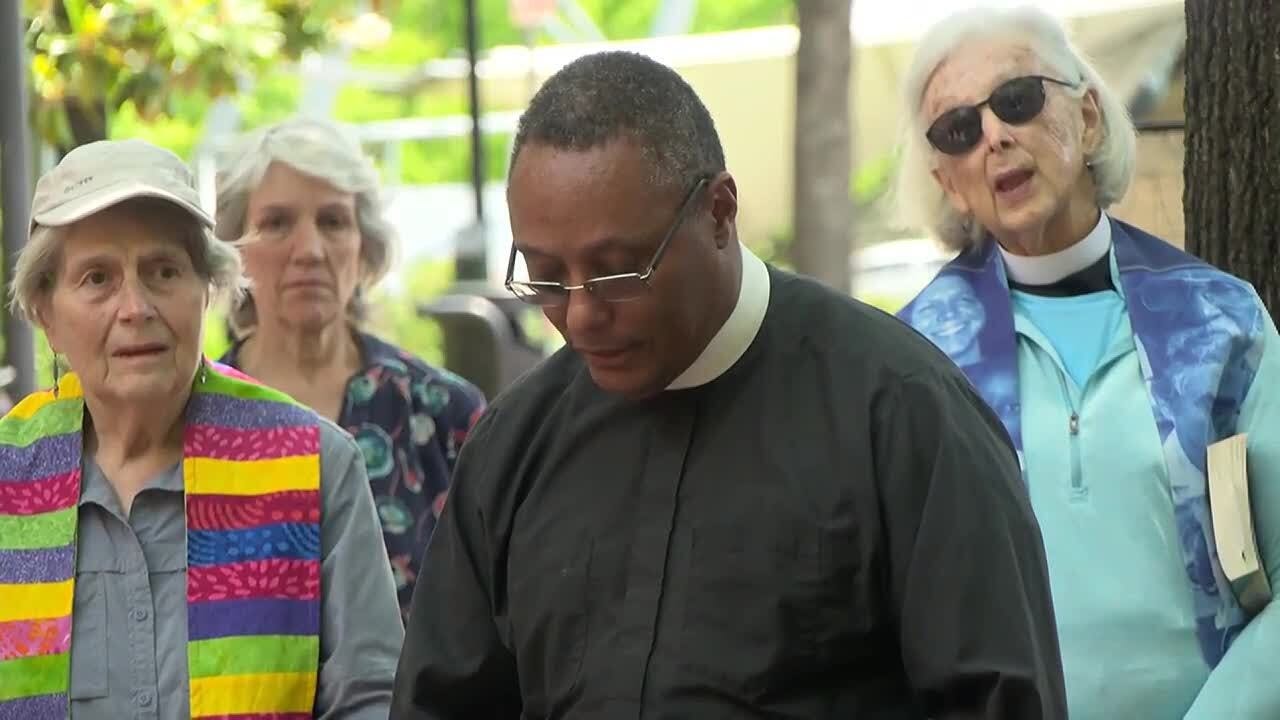
Protesters Confront GOP Lawmakers Over Trump’s “Big, Beautiful Bill”
At a press event outside Colorado’s state Capitol, U.S. Rep. Gabe Evans, U.S. Rep. Lauren Boebert and other GOP lawmakers were met with vocal protests as they defended Trump’s new spending bill. While Evans promoted the bill’s tax cuts and border security funding, demonstrators, concerned about cuts to Medicaid and SNAP, challenged its impact on vulnerable communities. Protesters, including seniors and local residents, gathered to hold Evans accountable for supporting legislation they say will harm thousands.12
Miami Scientists Protest Cuts to Hurricane Forecasting Programs
Former NOAA scientist John Cortinas and other weather experts led a protest in Miami against Trump administration proposals to slash funding for hurricane research and emergency preparedness. The cuts would eliminate NOAA’s Office of Oceanic and Atmospheric Research (OAR), which plays a key role in developing forecasting models and collecting storm data via hurricane hunter aircraft.
With an above-average hurricane season forecasted, experts warn that defunding OAR and reducing FEMA support could severely undermine public safety. Local National Weather Service offices are already facing staffing shortages, and scientists argue that these cuts would halt progress in forecasting rapidly intensifying storms, leaving communities more vulnerable to extreme weather.13
Tennessee Advocates Protest Trump’s Medicaid and SNAP Cuts
In Nashville, advocates for children, seniors, people with disabilities, and caregivers rallied against Trump’s proposed Medicaid and SNAP cuts, warning of devastating impacts on vulnerable communities. Led by the American Heart Association and supported by 11 nonprofits, speakers shared personal stories of survival and caregiving, emphasizing how Medicaid has enabled access to life-saving care and helped families avoid poverty. Advocates stressed that these programs are lifelines, not luxuries, and called the legislation “cruelty disguised as reform.” Their message was clear: cutting support for the most vulnerable is not just bad policy—it’s a threat to lives and livelihoods.14

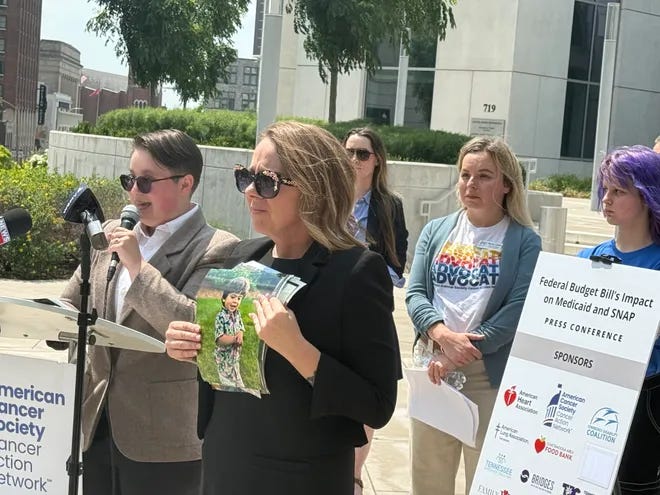
Arizona Students Rally to Defend Higher Education from Trump Cuts
Students and Democratic lawmakers gathered at the Arizona Capitol to protest the Trump administration’s education policies, which include proposed cuts to Pell Grants, restrictions on diversity programs, and increased immigration enforcement on campuses. Organized by the Arizona Students’ Association, the rally called for protecting funding for higher education and ensuring inclusive, safe learning environments for all students, including international and LGBTQIA+ communities. Protesters also condemned ICE activity on campuses, calling for policies that support, rather than target, vulnerable student populations15.
Jewish Organizers Push Back Against Trump’s Crackdown on Higher Education in the Name of Antisemitism
Jewish students, faculty, and alumni across the U.S. are increasingly mobilizing against the Trump administration’s use of antisemitism allegations to justify repressive actions on college campuses. In response to funding cuts, student detentions, and restrictions on academic freedom, Jewish organizers are leading protests, lobbying lawmakers, and forming networks to defend both Palestinian rights and democratic norms. Groups like Jewish Voice for Peace have seen surging membership, while thousands of Jewish academics have signed letters opposing the administration’s actions and supporting detained students.16

Michigan Protesters Rally to Defend Constitutional Checks and Balances
In Paw Paw, Michigan, demonstrators gathered for the “Constitutional Crisis March” to protest what they view as the Trump administration’s disregard for constitutional checks and balances. Organized by Indivisible Southwest Michigan, the event also raised funds for a local food pantry.17
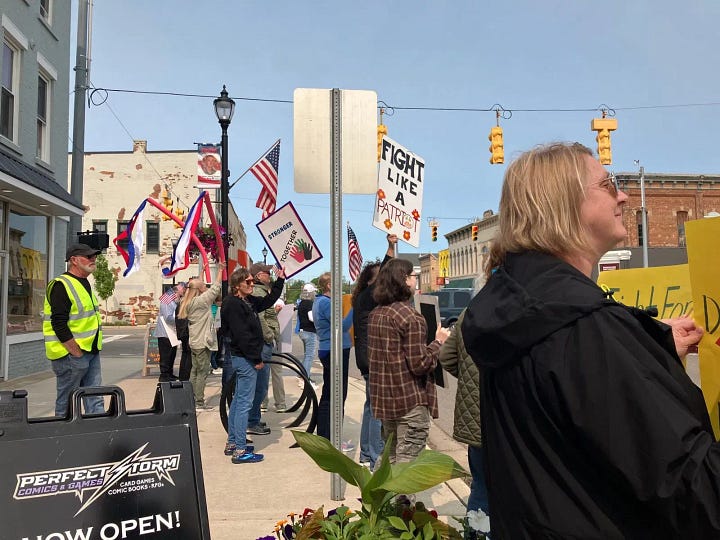

Harvard Students Rally to Defend International Students and Academic Freedom
More than 300 students and faculty rallied at Harvard University to protest the Trump administration’s attempt to block the school from enrolling international students by restricting access to the SEVIS system. Organized by Harvard Students for Freedom, the demonstration united students across ideological lines to defend academic freedom and constitutional rights. The rally drew support from students and faculty across Boston, including Northeastern University, and featured personal testimonies from international students and Jewish leaders who condemned the administration’s actions as divisive and discriminatory. Organizers pledged to continue building a national student movement to resist federal overreach and protect higher education institutions from political interference.18
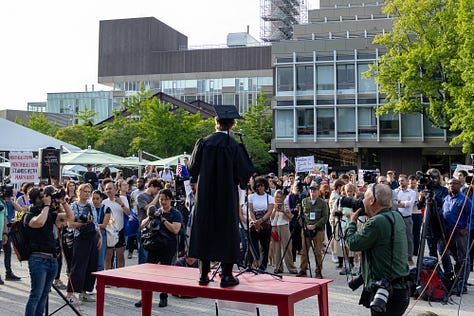
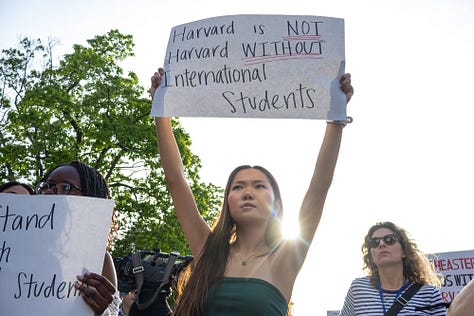
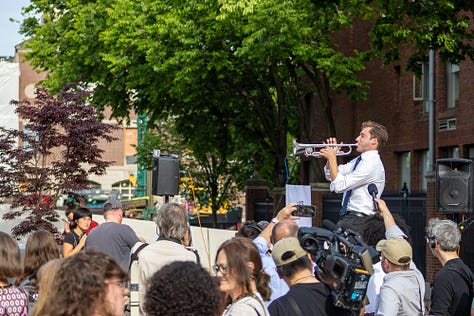
Citizens Defy State Restrictions to Light Jacksonville Bridge for Pride
In Jacksonville, Florida, hundreds of LGBTQ+ activists and allies gathered to light the Acosta Bridge in rainbow colors, defying a state-imposed restriction on bridge lights in colors other than red, white, and blue. Despite a suspiciously timed road closure and an unexpected drawbridge lift on the originally planned Main Street Bridge, organizers quickly pivoted to a backup plan. They led participants, armed with 146 rainbow-colored flashlights, to the Acosta Bridge, where the event continued undeterred. This turned out to be a fortuitous change of plans, as it not only preserved the celebration but also created a powerful visual moment, with reflections of both the pride and transgender flag colors shimmering side by side in the reflections of Saint John’s River.19 20
Veterans Rally Nationwide on the Anniversary of D-Day
More than 5,000 veterans and allies gathered on the National Mall—joined by over 200 actions across the country—to protest the Trump administration’s plan to eliminate 80,000 VA jobs and cancel hundreds of community service contracts. Veterans say the cuts are already causing canceled appointments, staff departures, and unsafe conditions, despite administration claims that healthcare and benefits won’t be affected. The proposed budget slashes $12 billion from VA medical services while boosting private sector care funding by 50%.
Veterans and organizers see the move as a deliberate attempt to dismantle the VA, the nation’s largest public healthcare system, and replace it with a privatized model that lacks oversight and cultural competency. Drawing inspiration from the 1932 Bonus Army march, speakers emphasized the long history of veterans mobilizing to defend their rights. The protest marked a powerful stand for public healthcare, accountability, and the promises made to those who served.21

Challenging ICE
President of California’s Largest Labor Union Arrested at ICE Protest
David Huerta, president of Service Employees International Union (SEIU) California, was injured and detained while documenting an ICE raid in Los Angeles, prompting widespread condemnation from labor leaders, elected officials, and immigrant rights advocates. Huerta, a prominent labor figure, was observing the raid when federal agents arrested him, claiming he obstructed their operation. He was hospitalized and later transferred to a federal detention center.
Officials across California, including Governor Gavin Newsom and Senate President Pro Tem Mike McGuire, called for Huerta’s immediate release, denouncing the use of force and the broader escalation of immigration enforcement under the Trump administration. Hundreds rallied outside the detention center, demanding justice and reaffirming their commitment to defending immigrant communities. Huerta’s arrest has become a flashpoint in the growing resistance to aggressive federal immigration tactics.22
Massachusetts Students and Teachers Walk Out to Protest ICE Arrest of Classmate
Students and teachers at Milford High School in Massachusetts staged a walkout to protest the detention of 18-year-old student Marcelo Gomes Da Silva by ICE agents. Gomes Da Silva, a Brazilian national who entered the U.S. on a student visa and plans to apply for asylum, was detained while driving his father’s car, though ICE officials admitted he was not the original target of the investigation.
The protest, supported by the Massachusetts Teachers Association, drew hundreds of students and educators, who condemned the arrest as “cruel” and “inhumane.” Community members also marched to town hall, and a federal judge has temporarily barred ICE from transferring Gomes Da Silva out of Massachusetts while his legal case proceeds.23
UPDATE: Marcelo has been released!
Marcelo Gomes Da Silva was released from ICE detention after six days, following a judge’s order and widespread community support. Speaking after his release, Gomes Da Silva described harsh conditions in detention and expressed a desire to help others still in custody.24
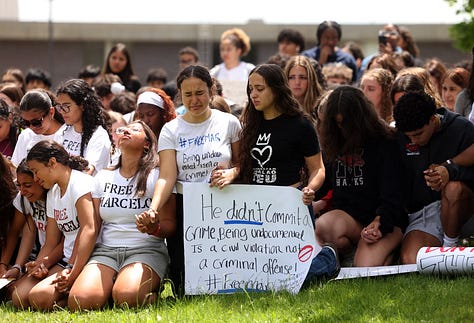
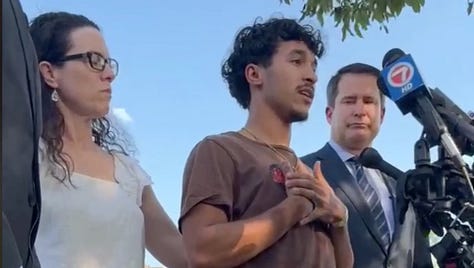
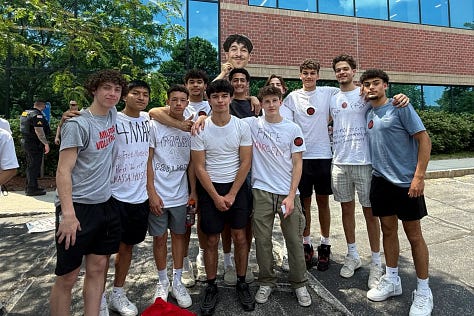
New York Community Protests ICE Detention of Longtime Resident
Residents of Glens Falls, New York, rallied in support of Yuriy Zinovyev, a longtime local resident detained by ICE during a routine immigration check-in. Zinovyev, who has lived in the U.S. for 25 years after emigrating from Kazakhstan, was arrested despite having legal status to work. Friends and community members say he has no family in the U.S. and has consistently complied with immigration requirements. Congressman Paul Tonko called the arrest “concerning” and emphasized that immigrants should not fear deportation for following the law. The protest reflects growing resistance to ICE’s opaque tactics and the broader climate of fear under the Trump administration’s immigration policies.25
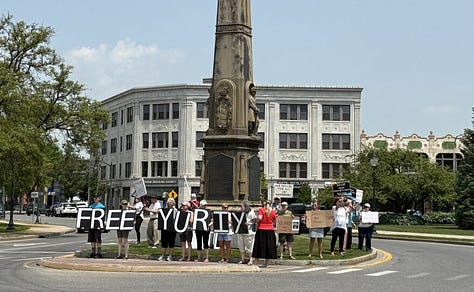

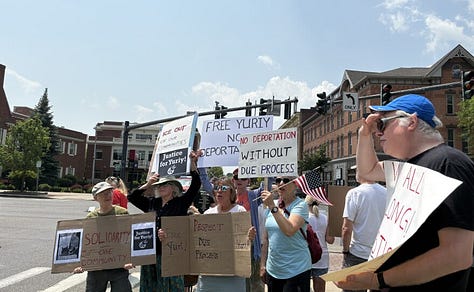
Chicago Community Demands Release of Detained Grandmother
Immigrant rights advocates are calling for the immediate release of Gladis Yolanda Chavez Pineda, a longtime Chicago resident and grandmother detained by ICE during a routine check-in. Despite having no criminal record and being under electronic monitoring, Chavez Pineda was arrested without warning while accompanied by her attorneys, who were later asked to leave the building. Chavez Pineda has lived in the U.S. for a decade and is known for her advocacy and community work. Supporters continue to rally for her release, warning that such tactics send a deliberately chilling message to immigrant communities.26
San José Protesters Demand Immigrant Rights, Oppose Trump’s Citizenship Rollback
In San José, up to 100 protesters rallied to defend immigrant and Chicano rights and oppose the Trump administration’s attempt to revoke birthright citizenship. Organized by the Silicon Valley Immigration Committee and allied groups, the demonstration included a press conference and march targeting ICE operations and calling for legalization for all.
Speakers condemned deportations of U.S. citizen children and the broader climate of fear created by immigration enforcement. Local leaders and activists demanded congressional action and vowed continued resistance.27 28
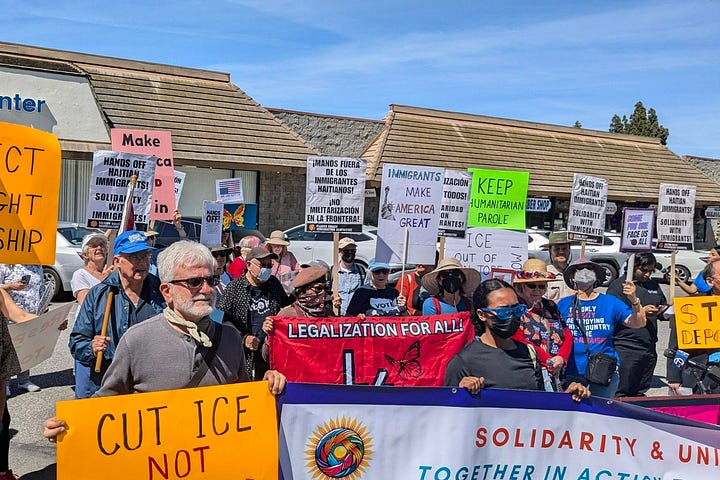
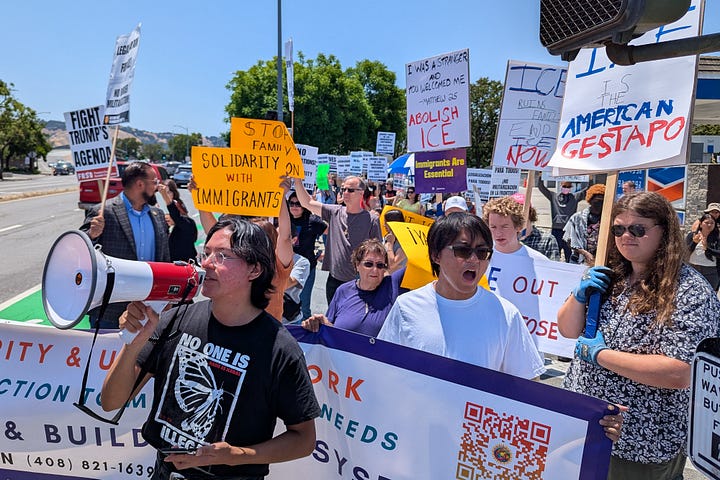
Chicago Residents Force ICE to Retreat from Little Village Through Rapid Response Network
In Chicago’s Little Village neighborhood, residents and immigrant rights activists successfully confronted and drove out ICE agents on June 3. Members of the Chicago Alliance Against Racist and Political Repression (CAARPR) used rapid response tactics after spotting unmarked vehicles with law enforcement officers refusing to identify themselves. As neighbors gathered and distributed “know your rights” materials, the agents fled the area, running red lights and evading through alleys.
Local officials and activists remain vigilant, with ICE sightings increasing and federal officials openly criticizing Chicago’s strong community education efforts. The swift, coordinated response in Little Village underscores the power of grassroots resistance in protecting vulnerable communities.29
L.A. Residents Confront and Expel ICE Agents
Community members in Boyle Heights, Los Angeles, mobilized rapidly after spotting suspected ICE agents at Mariachi Plaza. Activists from Centro CSO and local businesses quickly gathered, leading chants and rallying support. When a black SUV linked to Homeland Security returned, protesters surrounded the vehicle, forcing it to retreat. Though agents claimed they were not ICE, Trump’s recent executive order allows multiple federal agencies to act in ICE’s stead, blurring lines and escalating community fears.
The confrontation underscores the power of organized, local resistance. Centro CSO is calling for continued action, including a protest on June 8 demanding an end to ICE presence in neighborhoods, courts, and public transit. Residents say they will not allow federal agents to intimidate or destabilize their communities.30
Advocates Protest Expansion of Georgia ICE Detention Center
Immigrant rights activists rallied in Atlanta to oppose the proposed expansion of the Folkston ICE Processing Center, which would become the largest immigration detention facility in the U.S. if approved. The plan would nearly triple the center’s capacity from 1,100 to almost 3,000 beds. Protesters cited widespread abuse and neglect in detention centers and called for the facility’s complete closure, arguing the expansion would not improve safety or economic conditions.31
San Diego Residents Rally Against ICE Raid on Local Restaurant
Community members in San Diego are protesting a violent ICE raid that took place at Buona Forchetta, a popular neighborhood restaurant, where heavily armed agents used flash-bang grenades and detained multiple employees. Outraged by what they describe as a militarized and unjustified operation, residents and advocacy groups gathered outside the Federal Building to demand ICE leave the city and cease its aggressive tactics.
Speakers from local organizations condemned the raid as an attack on working people and a threat to community safety. Activists say the incident reflects a broader pattern of escalating immigration enforcement under the Trump administration and are calling for continued resistance to protect immigrant communities.32 [Video]
Chicago Officials and Residents Confront ICE Over Aggressive Detentions
In a powerful show of resistance, Chicago aldermen (city council members) and community members clashed with ICE agents outside a South Loop immigration office, protesting the detention of immigrants under Trump administration policies. The protest was sparked by the disappearance of a local resident during a routine check-in, prompting rapid mobilization by immigrant rights groups and elected officials. Aldermen formed a human chain to block ICE vans, resulting in physical altercations with federal agents.
The protest reflects a broader wave of grassroots resistance to ICE operations nationwide, as communities report increased raids and detentions, particularly targeting recent arrivals. Advocates and attorneys warn that expedited removal tactics are undermining due process and creating fear among immigrants trying to comply with legal proceedings. Local leaders, including Mayor Brandon Johnson and U.S. Rep. Delia Ramirez, condemned the federal actions and pledged continued support for immigrant communities.33 34
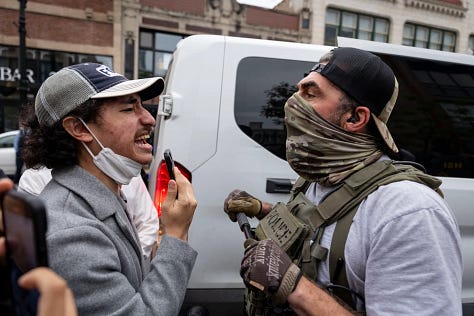
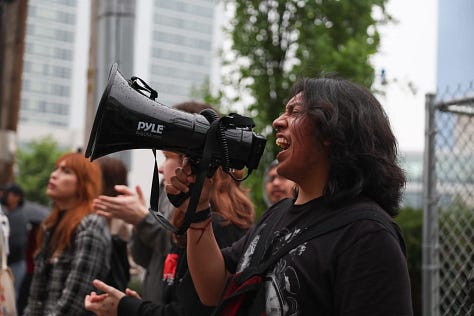
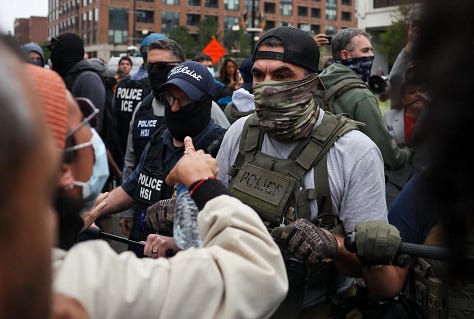
Minneapolis Protesters Confront ICE Raid Backed by Local Police
Hundreds of protesters gathered in Minneapolis after a multi-agency federal raid on a local taco restaurant sparked outrage and confusion. The operation, led by ICE under Trump’s newly reactivated Homeland Security Task Force, involved at least 11 federal agencies and local law enforcement, including the Minneapolis Police Department, despite city leaders’ prior commitments not to assist in civil immigration enforcement. Officials claimed the raid targeted drug and money laundering crimes, not immigration violations, but protesters and local officials questioned the presence and tactics of ICE.
The protest, which included Minneapolis City Council Member Jason Chavez, echoed broader resistance to the Trump administration’s aggressive deportation agenda and its pressure on local agencies to cooperate. Demonstrators blocked vehicles, challenged officers, and denounced the use of force, including chemical irritants. The incident underscores growing tensions between federal enforcement and sanctuary-minded communities determined to protect immigrant rights.35
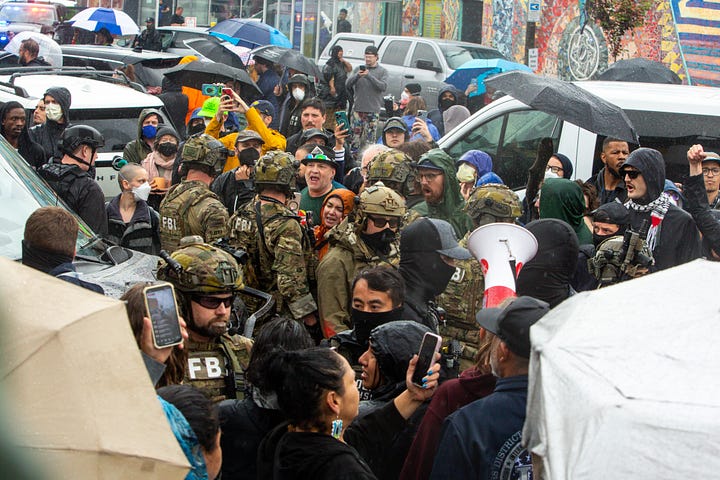
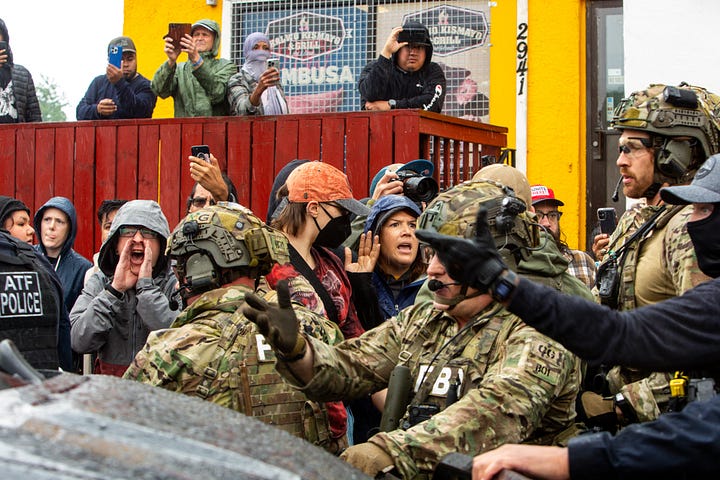
L.A. Protesters Faced Military-Style Force in Confrontation with ICE
Federal agents used flash-bang grenades, riot gear, and less-lethal ammunition during a sweeping immigration raid in Los Angeles’s Fashion District, sparking outrage and protests. The raid, one of several across the city, targeted a clothing wholesaler and resulted in over 100 arrests. Community members and immigrant rights advocates quickly mobilized, denouncing the aggressive tactics and the detention of workers, many of whom were immigrants from Mexico and South Korea.
The operation escalated tensions as protesters clashed with agents outside a federal detention center later that day. Among those arrested was Service Employees International Union (SEIU) California President David Huerta, prompting condemnation from Governor Gavin Newsom and other leaders. As ICE ramps up enforcement under Trump’s second term, activists and local officials are pushing back, reaffirming sanctuary policies and demanding accountability for what they describe as state-sanctioned violence against immigrant communities.
“As Mayor of a proud city of immigrants, who contribute to our city in so many ways, I am deeply angered by what has taken place. These tactics sow terror in our communities and disrupt basic principles of safety in our city. We will not stand for this.” — Mayor Karen Bass
Fighting Back in the Courts
Judge Rebukes Trump Deportation Tactics, Orders Due Process for Migrants
A federal judge has ruled that the Trump administration violated the rights of hundreds of migrants deported to a high-security prison in El Salvador by denying them the chance to challenge their removal. The migrants were expelled under a presidential order invoking the Alien Enemies Act, targeting alleged members of a Venezuelan gang. The court found that many may have been wrongly accused and emphasized that due process must apply, even in cases involving national security.
The ruling requires the government to propose a plan within a week to allow these individuals to seek habeas relief. This decision is a critical affirmation that constitutional protections extend to all people, regardless of immigration status.36 37 38
Contractors Sue to Stop Trump’s Shutdown of Job Corps Program
A coalition of Job Corps contractors has filed a federal lawsuit to block the Trump administration from eliminating the nation’s largest job training program for low-income youth. The lawsuit argues that the Department of Labor lacks the authority to dismantle a program created and funded by Congress, and that the abrupt closure would harm tens of thousands of young people and the organizations that serve them.
The legal challenge is part of a broader pushback against efforts to shrink federal programs that support vulnerable communities. Advocates are seeking an injunction to keep Job Corps running while the case proceeds.39
Haitian TPS Holders and Union Challenge Deportation Threat in Court
A federal court is expected to rule soon on a lawsuit filed by Haitian Temporary Protected Status (TPS) holders and the labor union 32BJ SEIU, challenging the Trump administration’s decision to end Temporary Protected Status for over 200,000 Haitians. The plaintiffs argue the move violates federal law and would upend the lives of immigrants who have lived and worked legally in the U.S. for years. They’re seeking to block the termination while the case proceeds.40
“I filed this lawsuit not just for myself and my wife, but for hundreds of thousands of my fellow Haitians here on TPS whose lives would be upended.” —Gerald Michaud, a Haitian immigrant who received TPS in 2010 after the devastating earthquake in Haiti
Newark Mayor Sues Trump-Appointed Prosecutor Over Arrest at ICE Protest
Newark Mayor Ras Baraka has filed a lawsuit against a top Trump-aligned federal prosecutor, alleging false arrest and political retaliation after he was detained during an oversight visit to an ICE detention center. Baraka, who is running in New Jersey’s Democratic gubernatorial primary, says the arrest was part of a broader pattern of targeting Democratic officials, including Sen. Cory Booker and Gov. Phil Murphy.
The charges against Baraka were dropped, and a federal judge questioned the legitimacy of the arrest. The incident has sparked wider scrutiny, with other House Democrats also facing charges or reporting mistreatment during similar visits. Baraka’s legal challenge is part of a growing push to hold federal officials accountable for what critics say is the politicized use of law enforcement powers.41
Two Cities Sue Trump Administration Over Sanctuary City Funding Threats
The cities of Chelsea and Somerville, Massachusetts, are taking the Trump administration to court over threats to strip their federal funding due to their sanctuary city policies. Local leaders argue the move is unconstitutional and an attempt to coerce cities into enforcing federal immigration laws, something they say undermines public safety and local autonomy.
With millions in federal funding at stake for essential programs like education, homelessness prevention, and infrastructure, the cities are standing firm. Legal advocates note that Congress never required immigration enforcement as a condition for these funds, and courts have blocked similar efforts before.
"Chelsea will not be bullied or intimidated into enforcing federal immigration laws, and we will not allow federal policies to dictate how we care for people that call Chelsea home." Fidel Maltez, Chelsea City Manager
Blue State AGs Formulate Second Phase of Their Attack Plan
Democratic attorneys general from Massachusetts, California, and New Jersey are intensifying their coordinated legal efforts to challenge the Trump administration’s policies in areas such as immigration, consumer protection, and the alleged politicization of federal agencies. They have collectively filed 30 lawsuits since Trump’s return to office, targeting actions they argue violate legal norms and harm their constituents. Their strategy includes both litigation and proactive community guidance, particularly for immigrant populations.
The attorneys general are also pushing back against what they describe as the weaponization of government institutions, including attempts to misuse IRS data and undermine nonprofit organizations. They are stepping in to fill gaps left by weakened federal oversight, especially in consumer protection and public safety, and remain committed to monitoring and responding to any future actions by the administration that they believe cross legal boundaries.42
Judge Blocks Trump’s Executive Order Targeting Harvard’s International Students
A federal judge has temporarily blocked the Trump administration’s latest attempt to bar international students from enrolling at Harvard University. The order, issued by Judge Allison D. Burroughs, halts a presidential proclamation that Harvard argues is part of a broader political campaign to punish the university. This marks the third such attempt by the administration, but the first to rely directly on executive power rather than agency rules.
Harvard’s legal complaint accuses the administration of violating court orders and using immigration policy to retaliate against the university for resisting federal demands, including audits of “viewpoint diversity.” The ruling protects thousands of international students and underscores ongoing legal resistance to policies seen as undermining academic freedom and global engagement in higher education.43
Immigrant Rights Groups Sue to Block Trump’s El Salvador Prison Deal
A coalition of immigrant rights organizations has filed a federal lawsuit challenging the Trump administration’s agreement to detain migrants in El Salvador’s CECOT prison. The lawsuit argues that the deal violates the U.S. Constitution by placing detainees beyond the reach of U.S. courts and denying them due process. It also claims the agreement was made without legal authority and contradicts existing U.S. laws, including the First Step Act. The plaintiffs aim to halt what they describe as an unlawful and inhumane policy that undermines constitutional protections and international human rights standards.44
Court Forces Trump Administration to Reverse Unlawful Deportation
In a rare reversal, the Trump administration has returned a Guatemalan asylum seeker, identified as O.C.G., to the U.S. after a federal judge ordered his return. Deported to Mexico without a hearing, despite a prior ruling granting him protection from removal to Guatemala, O.C.G. was flown back to California and taken into ICE custody. His case is part of a broader class-action lawsuit challenging deportations to third countries without due process.
The legal victory marks the first known instance of the administration complying with a judicial order to return a deportee. Similar cases involving other deported individuals are still pending, with pressure mounting on federal agencies to comply with court rulings.45
19 States Push Back Against Trump’s Election Overhaul Order
Nineteen Democratic attorneys general have filed a federal lawsuit challenging Donald Trump’s executive order aimed at overhauling U.S. elections, arguing it violates the Constitution’s separation of powers. The order mandates proof of citizenship to vote in federal elections, bans counting mail ballots received after Election Day, and ties federal funding to compliance with these rules. Critics say it infringes on states’ rights to manage elections and could disenfranchise eligible voters.
The lawsuit, supported by a bipartisan group of former secretaries of state, warns that the order would dangerously expand executive power. A separate court has already blocked the proof-of-citizenship requirement, citing overreach. Advocates see the legal challenges as a vital defense of democratic norms and state authority in the face of federal overreach rooted in false claims of voter fraud.46
Kilmar Abrego Garcia Has Been Returned to the United States
Kilmar Abrego Garcia, a Maryland resident mistakenly deported to El Salvador in March, has been returned to the U.S. following a months-long legal standoff between the Trump administration and the federal judiciary. Despite a judge’s 2019 order barring his deportation due to credible fears of gang violence, Abrego Garcia was sent to a notorious Salvadoran prison. The administration initially claimed it lacked the power to bring him back, defying court orders and drawing bipartisan concern over its disregard for due process.
His return marks a rare judicial victory in a climate of aggressive immigration enforcement. While Abrego Garcia now faces federal charges, his case has become a flashpoint in the broader fight over executive overreach and immigrant rights. Advocates argue that the judiciary’s insistence on compliance with constitutional protections is a critical check on unchecked deportation powers.47
That’s all for this week! Thanks for reading
M-.
* To my podcast listeners: Thanks for listening to the pilot of the How to Resist podcast. Unfortunately, I’ve decided not to continue the podcast until a time when I have more resources (time and funding) to make it a sustainable long-term commitment. I hope these letters will be a way to still speak directly to you, although in a different way. If you are interested in an audio version of this post read by Substack’s AI tool (which isn’t as bad as it sounds!), download the Substack app, navigate to the post, and look for the play button in the top right-hand corner. Thanks for listening, and thanks for being part of How to Resist! M-.
Support How to Resist
As a librarian writing in the service of democracy, I’m determined to keep How to Resist free to read and publicly available for everyone.
If this work matters to you and you’re able to support it, please consider a paid subscription and help keep How to Resist going for as long as it’s needed.
Prefer a one-time contribution? You can donate at ko-fi.com/howtoresist





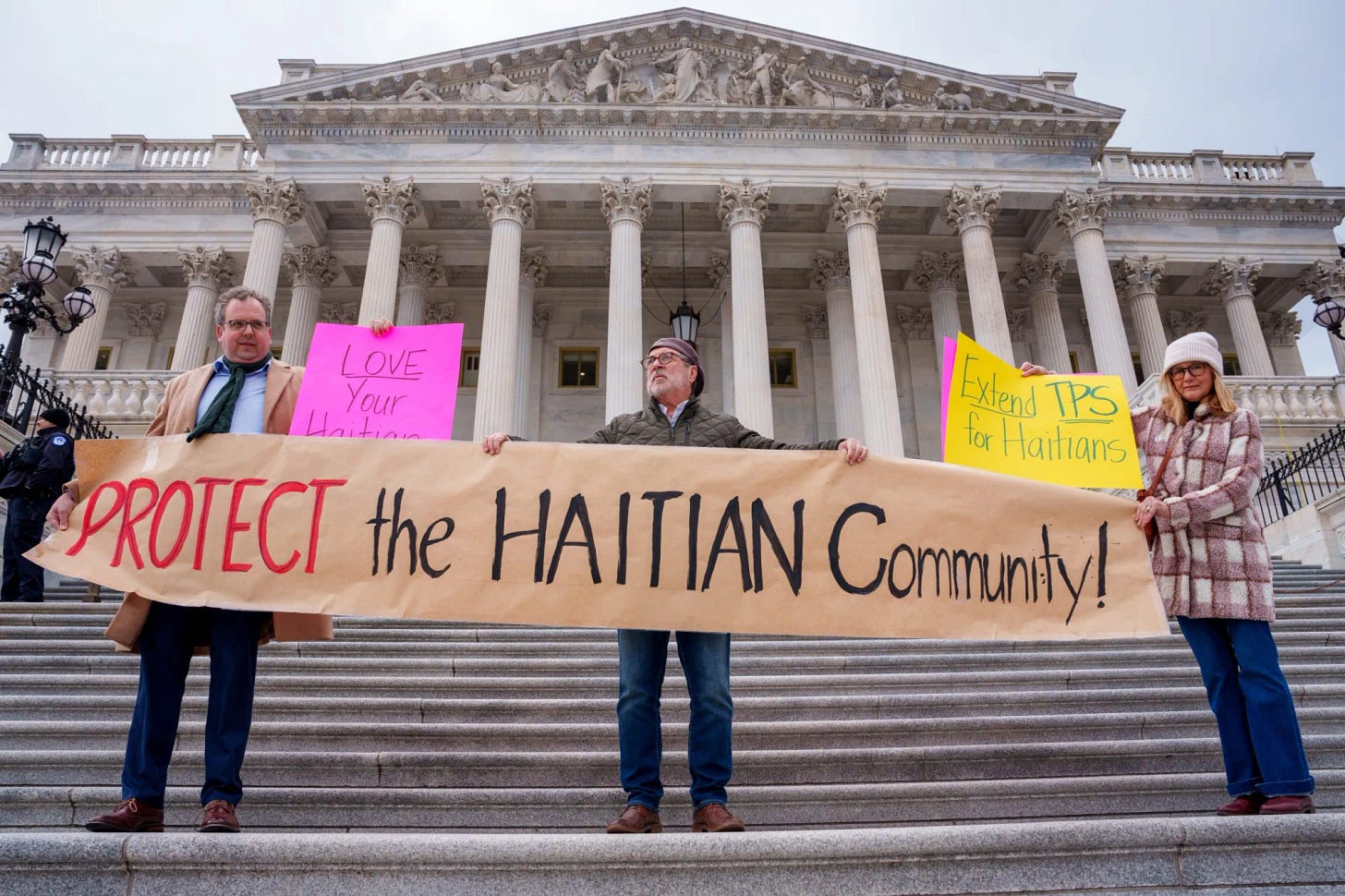
That us quite an impressive list! Let's spread the word far and wide. This 'administration' doesn't want us to know how effective the resistance is. Fine. Let's return the favor. We won't let them know. We'll just keep on resisting til breakthrough.
Thank you for telling all these stories! Amplification is key to fighting fatigue and it is the foundation of hope in these dark days!